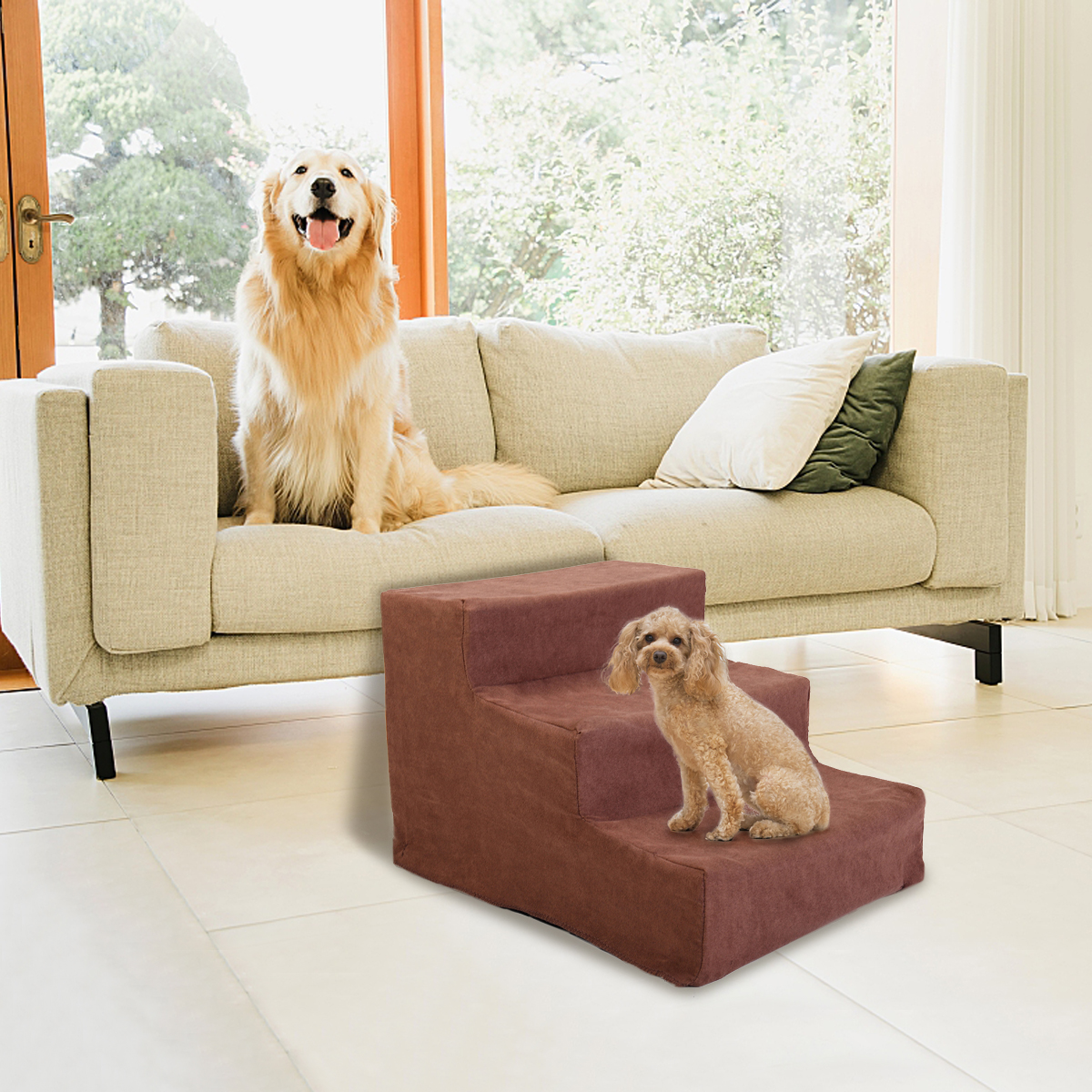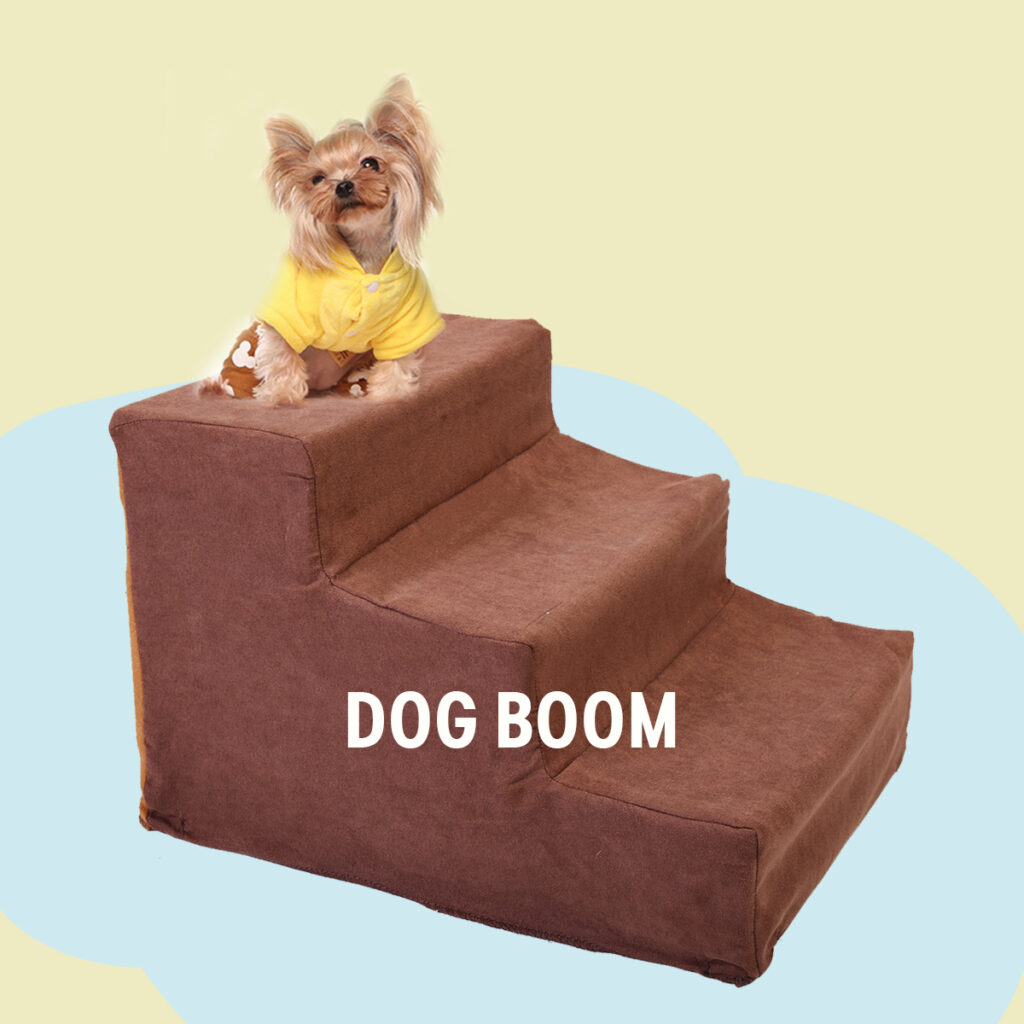It can be upsetting for pet owners when their dog becomes injured or struggles to reach the furniture or jump into the car due to age. We always strive to provide a loving, supportive environment for our dogs, and dog steps are one of the best ways to help an elderly or injured pet.
Knowing which style and build of dog stairs to choose from can be difficult, especially given the variety of models on the market today. To find the safest, most efficient staircase for your dog, consider different materials, sizes, and finishes.
Choosing the Right Material
Dog stairs can be made of a variety of materials, the most common of which are wood or high-density foam. They both have advantages and disadvantages. Finally, the best option is determined by your dog’s size and weight, the layout of your home, and your specific needs.
● Wood Stairs
Wooden dog stairs are one of the most durable materials for dog steps, typically lasting longer than high-density foam. The wooden finish on the stairs, on the other hand, is easily scratched by a dog’s nails and can be damaged if wet.
When deciding on the material for your steps, keep your dog’s size and weight in mind. Sturdy wooden steps will benefit a larger dog. It’s a good idea to choose hardwood steps for large dog breeds that weigh more than 100 pounds. If you have a smaller dog, a softwood staircase, such as pine, is appropriate.
By selecting a finish that complements your interior design scheme, wooden steps can also add an upscale touch to your decor.
● High-Density Foam Stairs
Another excellent choice for the base material of your dog stairs is high-density foam. This lightweight and robust material is easy to move, allowing you to relocate the stairs in your home and give your dog easier access to more areas.
Because high-density foam cannot support as much weight as a wooden base, this is a better option for smaller dogs. Check the load capacity of any staircase before purchasing to ensure that it is safe for your dog.
High-density foam does not last as long as wooden frames and will wear down or become unstable if not properly cared for. Check for stability on a regular basis to ensure that the dog stairs do not begin to rock as they wear down. Replace them as soon as you notice any flaws.
● Carpeted Stairs
You’ll still need to choose a wood or high-density foam base, but carpet as an exterior finish is worth considering. Suitable for high-energy dogs, the carpet protects the stair frame from scratches and wear, and it can help prevent your pet from slipping.
If you can find a carpeted finish that you can remove and machine wash, this is the best way to keep your dog steps clean and odor-free.
One Size Does Not Fit All
Because no two dogs are the same size, there are several factors to consider when choosing the stairs your dog requires, such as the number of steps, the depth of the stairs, ease of storage, and portability.
Dogs find narrow stairs difficult to navigate and are sometimes afraid to try them. To make the staircase as comfortable as possible for your dog, look for steps that are 6″ to 8″ high and 10″ to 12″ deep. Check the staircase measurements three times to ensure that your dog will not find the stairs more difficult to climb than jumping onto the furniture or into the car.
Choosing Safe Dog Stairs
You value your dog’s health, which is why you should buy dog staircase products from a reputable manufacturer. If you carefully read product descriptions, you can easily find staircases that have been tested to support your dog’s weight.
Staircases that collapse for easy storage when not in use are also available. While this is extremely useful and makes cleaning your room easier when the dog isn’t using the product, it also means you must set up the staircase correctly each time so it doesn’t collapse while your dog is on it.
Read all of the included instructions on safe setup procedures carefully. If the staircase becomes unstable after a few months of being put up and taken down, seek a repair or replacement.
Stairs vs. Ramps
A variety of ramps may appear in your research when deciding which stairs to buy for your dog. The option of a ramp versus stairs is worth considering, especially if you live in a single-level home or apartment and your senior dog has never had to climb stairs before. This may be difficult to teach him in his old age, and in that case, a ramp may be more comfortable.
A ramp is also a good option if your dog already has difficulty navigating any stairs in your home. If your dog is already comfortable climbing stairs and does not appear to have difficulty with them, dog stairs are the best option because they take up less space in your home. Ramps take longer to reach the same height at a safe angle and are less aesthetically pleasing or functional than a staircase, which can serve as a storage unit or collapse for easy organization.
The Best Dog Stairs For Your Home
Designing a pet-friendly space does not have to mean sacrificing style. Dog stairs are available in a variety of colors, finishes, and sizes, allowing you to find one that matches your décor.
To keep your space looking nice, try to find a staircase that matches the flooring or furniture in the room you’ll be keeping it in. If your bedroom floor is hardwood, look for a staircase that has a similar stain color and wood grain. A closely colored carpet finish on the stairs will add a subtle touch to the carpeted room.
Taking care of a senior pet or a dog who has recently had surgery or been injured can be a daunting task at times. Nobody wants to see their beloved animal suffer, which is why providing a staircase to easily access all spaces is such a valuable addition to your home.


